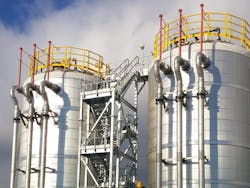iWWD – Slave Lake Pulp, a Div. of West Fraser Mills Ltd.
Cost: $40 million
Location: Slave Lake, Alberta, Canada
Year: 2016-12-12
Size: 1,660 gpm
Owner: Slave Lake Pulp, a Div. of West Fraser Mills Ltd.
Designers: ADI Systems
Contractor: Geomembrane Technologies Inc., Biogasclean
The town of Slave Lake in Alberta, Canada, has had more than its fair share of struggles. In 1988, the town suffered flood damage when nearby Sawridge Creek overflowed its banks. In May of 2011, wildfires decimated 40% of the town; as residents endeavored to rebuild, more floods arrived mere months later.
Two years after the wildfire and subsequent flooding, Slave Lake Pulp, a Div. of West Fraser Mills Ltd., was fighting its own battle. Slave Lake Pulp, a 240,000-tonne-per-year Bleached-Chemi-Thermo-Mechanical Pulp (BCTMP) mill, processes aspen to produce hardwood pulp for the global market, to be used in products such as coated board grades, printing and writing papers.
Slave Lake Pulp was using a conventional activated sludge system to treat its high-strength wastewater, but this process was energy-intensive. The mill sought a solution that could cope with the fluctuations in its wastewater’s chemical oxygen demand (COD) concentrations (from 5,000 to 19,000 mg/L) caused by the mill’s frequent alterations in pulp brightness grades. It also desired power generation capabilities. With help from the Climate Change and Emissions Management Corp. and the Government of Alberta, the mill began a biomethanation and power generation project.
Slave Lake Pulp contracted with ADI Systems to install a wastewater treatment and biogas treatment system at the mill. ADI installed a 120,000 cu meter ADI-BVF reactor system for anaerobic effluent pre-treatment—the first “low-rate” anaerobic digester installed at a North American pulp and paper mill.
The reactor consists of an earthen basin with concrete perimeter wall lined with a geotextile underlay and a geomembrane liner and insulated cover. The geomembrane cover captures biogas from the reactor, which is scrubbed in a BioGasclean biological scrubber system to reduce its concentration of hydrogen sulfide (H2S). The BioGasclean system includes two 550 cu meter scrubbing tanks containing packed media and Thiobacillus bacteria.
The scrubbed biogas is burned in a new co-generation facility, producing up to 6 MW of green electricity for Slave Lake Pulp to use. The mill has boosted capacity up to 9 MW by using natural gas as a supplement to treated biogas.
Despite the technical and personnel changes incurred when working in Slave Lake—including a challenging labor market, high winds, harsh winters and few winter daylight hours—the highly concentrated mill wastewater, and the high sulfur content of the biogas, the project was completed in June of 2016.
The BVF reactor digests more than 85% of the BOD anaerobically, enabling Slave Lake Pulp to decommission two of its four existing aeration basins. Chemical usage is down by 50% to 70% and, of course, Slave Lake Pulp also is benefitting from its new energy source.
“Energy recovery through biogas utilization is very attractive for energy-intensive industrial plants, such as those within the forestry sector,” said Daniel Bertoldo, ADI Systems. “The shift from the traditional approach of treating pulp mill wastewater with ‘high-rate’ granular sludge-based anaerobic reactors sets a new precedent for the industry.”
“We’re proud that we were able to deliver a solution that provided the projected financial, environmental and operational benefits to Slave Lake Pulp,” Bertoldo said.
Project Year: 2016-12-12Contractor: Geomembrane Technologies Inc., BiogascleanDesigners: ADI SystemsOwner: Slave Lake Pulp, a Div. of West Fraser Mills Ltd.Location: Slave Lake, Alberta, CanadaCost: $40 millionSize: 1,660 gpm